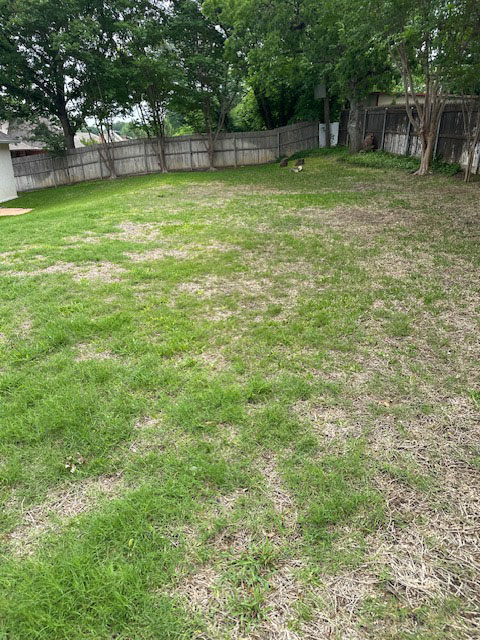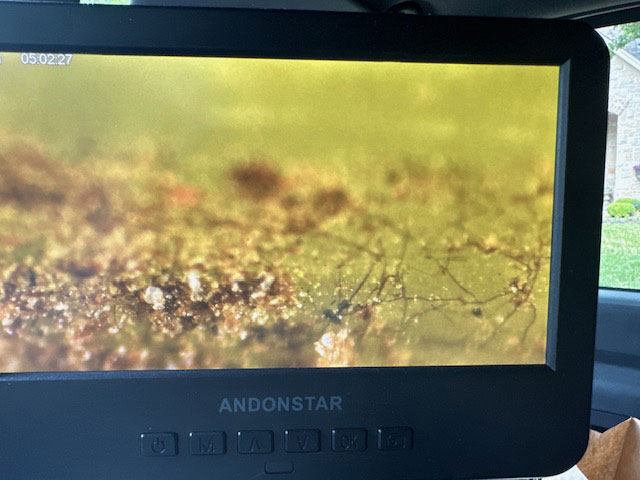Diagnosed and Treated by Agronomist & Owner, Aaron Shehan
If your St. Augustine or Zoysia lawn in Burleson is yellowing, weak, and not responding to fertilizer this spring—Take-All Root Rot (TARR) may be the issue. This soil-borne fungus causes widespread damage underground, and it’s becoming more common across North Texas.
From March through summer, we carry a microscope in the truck to help confirm Take-All Root Rot during onsite lawn evaluations. It’s not a guessing game. If the disease is active, we’ll show you exactly what’s going on—and give you a proven step-by-step plan to fix it.
🎥 Watch: What Take-All Looks Like and How We Diagnose It
- Take-All Root Rot Explained + Microscope Demo
- Peat Moss Application for Take-All Recovery
- Fungicide and Aeration Strategy for TARR
- Topdressing with Peat Moss – Before/After
What is Take-All Root Rot?
Take-All Root Rot is caused by the soil-borne fungus Gaeumannomyces graminis, which infects the roots and stolons of warm-season grasses. It’s most common in St. Augustine and Zoysia, and usually shows up in spring through early summer—especially in lawns with compacted soil, overwatering, or poor drainage.
📄 Learn more from Texas A&M:
Take-All Root Rot Fact Sheet (PDF)
Common Symptoms in Burleson Lawns
- Yellow or pale-green patches that don’t respond to fertilizer
- Turf lifts easily with little root resistance
- Damage worsens in cool, wet weather (March–June)
- Often misdiagnosed as drought or chinch bugs
- Lawn may continue thinning even with regular care
TARR Often Means Replanting
In many cases, new sod will be required after TARR weakens or kills the existing grass. That’s why early, accurate diagnosis is critical. The longer it’s ignored, the worse the root system gets.
Our Proven Take-All Root Rot Protocol
If Take-All is diagnosed, here’s the professional process used to recover the lawn and suppress the disease:
- Fix Drainage
- Redirect runoff and correct any low areas to eliminate standing water.
- Scalp Lawn to 2”
- Lower mowing height increases air flow and sun exposure to disease-prone zones.
- Verticut or Power Rake
- Remove thatch and decaying organic debris that holds moisture and fungus.
- Core Aeration
- Alleviate compaction and help oxygen reach the root zone.
- Topdress with Peat Moss
- Spread ¼ inch layer using 2 bales (3 cu. ft. each) per 1,000 sq ft
- Lowers soil pH and creates fungal suppression naturally
- Apply Fungicides at Curative Rates
- Use Azoxystrobin (Heritage) and Propiconazole (Banner Maxx)
- Avoid Propiconazole when temps exceed 85°F
- Reapply Peat Moss if Washed Out
- Heavy spring rains may displace it—reapplication is crucial to success
Ongoing Prevention in Burleson Lawns
- Don’t water in March or April unless grass shows drought signs
- Avoid early, high-nitrogen fertilization
- Aerate yearly to maintain healthy root structure
- Remove excess thatch in spring
- Monitor shady or compacted areas closely for symptoms
Final Word
Take-All Root Rot is serious—but with proper diagnosis and a smart, multi-step recovery plan, most lawns can bounce back. A microscope, a peat moss layer, and properly timed fungicides can turn the tide—but the earlier we act, the better.
“Our program won’t fix poor cultural practices—but we will give you an accurate diagnosis, a proven solution, and a straight answer about whether it’s time to replant.”
📞 Call 1-800-LAWNCARE or visit uglyweeds.com to schedule a lawn inspection or TARR consultation anywhere in Burleson or Johnson County.



